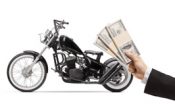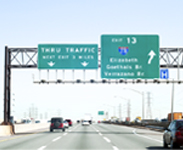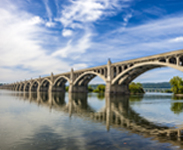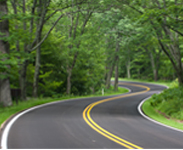Home > Motorcycle Community > Tips for Motorcycle Riders > How to Ride a Motorcycle in the Rain

How to Ride a Motorcycle in the Rain
Can you ride a motorcycle in the rain? Yes, you can! However, just because you know how to ride a motorcycle does not mean you know how to ride in the rain. Just like driving a vehicle when it is raining, there are additional considerations and precautions that you need to take. These tips for riding a motorcycle in the rain will help you stay safe.
Have the Proper Gear
Before you start motorcycle riding in the rain, you need to get the right waterproof motorcycle gear. Motorcycle rain gear is waterproof, not just water resistant. Materials like Gore-Tex prevent moisture from getting in. Dress in layers to stay warm and dry. Even when riding in the summer, riding in the rain can feel surprisingly chilly. In addition, raindrops hitting your face and body while riding can feel painful and be distracting.
An important tip for riding a motorcycle in the rain is to wear hi-viz gear. It may not look the coolest or most stylish, but it will make sure other drivers on the road see you. Safety and visibility are more important when motorcycle riding in the rain.
Fogging
Whether you are wearing a full-face helmet or goggles, fogging will be an issue. It happens when there’s moisture present with a temperature difference. If you wear a full-face helmet, it should have a Pinlock visor that prevents fogging. Another option is to give your eye protection an anti-fog treatment. Skip the DIY suggestion of soapy water. It won’t work as well as you hope it will. Buy an anti-fog treatment specifically designed for the job.
Rain Suit
Do not opt for cheap motorcycle rain gear. There are full suits and two-piece rain suit options. Both have their pros and cons. Most expensive rain suits are more comfortable to wear because they have breathability without sacrificing waterproofing. They also have small touches like waterproof zippers, protective flaps, and internal pockets.
Dry Bag for Personal Items
Have a “dry pocket” in your jacket, or get a dry bag for your personal items. This will protect your phone, wallet, and anything else you do not want to get wet.
Check Your Tires
Check your tire pressure and tread. You need enough tread on your tires to effectively channel water away from the tire. That way, your tires maintain better contact with the road. In addition to having tread, your tires also need to be properly inflated. Check the PSI and adjust as needed.
Use Rain Mode
Many modern motorcycles have a “Rain Mode” that automatically adjusts the motorcycle’s performance. Typically, it will smooth out the acceleration, increase the ABS for smooth braking, and increase powerful traction control.
Be Aware of Timing
The first 5 to 15 minutes of it raining are the most dangerous. The dirt, oil, and fuel collected on the road rise with fresh rainwater. This makes the road extra slippery. Many riders will pull over during this time, waiting for the contaminants to wash off the road. Depending on the road’s condition, rainstorm intensity, and the last time it rained will determine how long this extra-slippery phase lasts.
Adjust Your Speed and Lean
Motorcycle riding in the rain requires you to go slower and lean less. That way, you maximize rubber contact with the road while minimizing the risk of the bike sliding out from underneath you.
Watch Out For Oil Spots
Look at the road, and you will see a dark line down the center of the lanes. That line is oil, fuel, other car fluids, and dirt built up on the pavement. When it rains, these fluids float above the pavement, creating a slippery surface. One of the highest concentrations of this oily mess is at intersections, where cars remain stopped for extended time periods. To know where these oil spots are, look for extra shiny spots or swirling rainbows on the roads.
Avoid riding over these spots. They can cause your tires to lose traction. They can also make your boots slip if you try to put your feet down.
Avoid Puddles and Flooding
One of the most important tips for riding a motorcycle in the rain is to avoid puddles. There are so many risks associated with them. It is best to avoid them completely. You don’t know the depth of the water, if there are any hidden hazards, or if the water is moving. Riding through deep water could short out the electrical on your motorcycle. Finally, it could soak your brakes and make them useless.
Stay Out of Vehicle Spray
The passenger and commercial vehicles on the road will kick up spray from the water on the road. Try to avoid getting caught up in it. You’re at the biggest risk when riding behind other vehicles, passing them, or them passing you. Not only is this dirty road water unpleasant to have all over you, but the spray also hinders your ability to see when it hits your visor or goggles.
Watch Out for Slippery Conditions
Certain road conditions do not pose a threat when the road is dry. However, once wet, they become as slippery as black ice. Watch out for these, as they can be sudden riding hazards.
Painted Pavement Markings
The most common are the painted pavement markings. The newer they are, the more slippery they can be. You need to be vigilant when riding through a major intersection with crosswalks.
Sealer Snakes
Those long tar lines that zig-zag across the pavement are called sealer snakes. When wet, they can be like sporadic slippery spots that cause sudden loss of traction. Not being ready for them can create a jarring experience as you lose and suddenly regain traction. If there are a lot of them, this can create a black ice effect as you slide across multiple lines.
Metal Surfaces
From manhole covers to plates and grates, keep your eyes peeled for metal in the road. It becomes incredibly slippery when wet. Try to avoid riding over them while it is raining. If you can’t avoid it, then do so without making any speed or directional changes while over the metal.
Leaves
Fallen leaves collected on the road will cause you to lose all traction when wet. Avoid braking, accelerating, leaning, or making sharp turns while riding over wet leaves.
Ride the Dry Line
If you see an area of the road that is drier than the rest, try to ride there. Riding the dry line gives you better traction and maneuverability. Riders often forget to scan their surroundings. This results in them riding in a wet lane when the next one or two over isn’t as wet and safer.
Check Your Insurance
Before you put on your waterproof motorcycle gear and hit the open road, there is one last task. Check that your motorcycle insurance coverage is in good standing and that you are fully covered. Rain increases the risk of accidents. Motorcycle insurance protects you and your motorcycle, should an accident happen.
Speak with our knowledgeable team of insurance professionals about your motorcycle insurance.
This site and articles contained herein are provided for general informational purposes only and are not a substitute or intended as professional advice. Please be sure to refer to your owner’s manual or consult a mechanic for information specific to your motorcycle. The information contained on this site and articles contained herein are provided on an “as is” basis with no guarantees of completeness, accuracy, usefulness or timeliness and without any warranties of any kind whatsoever, express or implied. Rider Insurance Company and its affiliates (together, “Rider”) assume no responsibility for any errors or omissions in the content of this site and articles contained herein. Any action taken upon this information is strictly at your own risk and Rider will not be liable for any losses or damages in connection with your use of this site and articles. Additional terms and conditions apply and are available at https://www.rider.com/plymouth-rock-assurance-general-terms-and-conditions/.
Plymouth Rock Assurance is a marketing name used by a group of separate companies that write and manage property and casualty insurance in multiple states. Motorcycle insurance in New Jersey and Pennsylvania is underwritten by Rider Insurance Company. Each company is financially responsible only for its own insurance products. Actual coverage is subject to the language of the policies as issued by each separate company.





